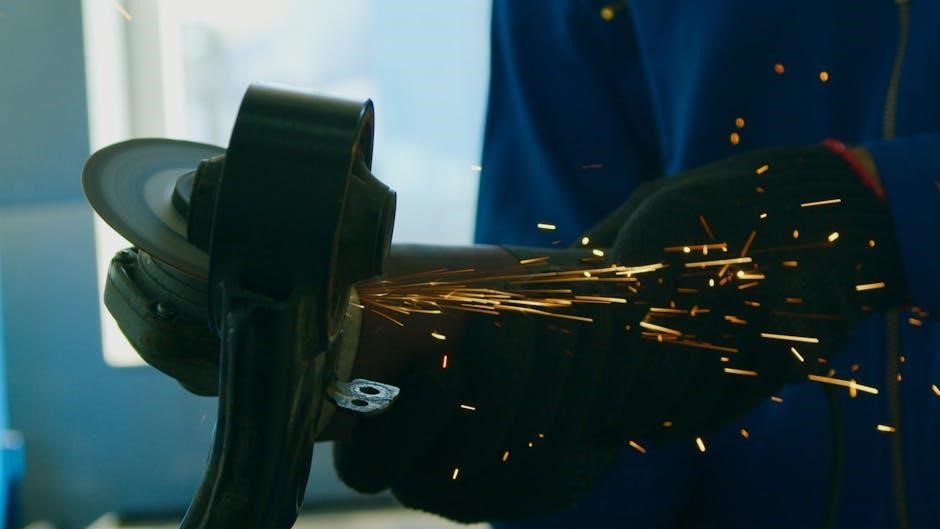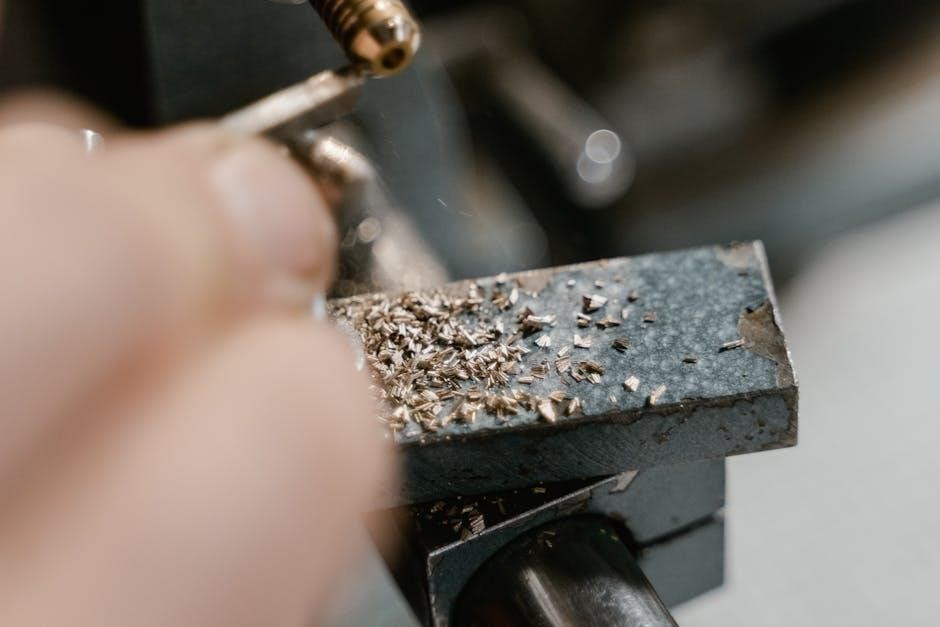Welcome to the AR-15 Operation Manual, your comprehensive guide to understanding and safely operating the AR-15 platform. This manual covers history, technical principles, safety, assembly, firing, maintenance, and troubleshooting. Designed for both novices and experienced users, it ensures safe and effective operation of your firearm.
1.1 History and Development of the AR-15
The AR-15, developed in the late 1950s by ArmaLite, a subsidiary of Fairchild Aircraft, revolutionized modern firearms with its innovative design. Led by Eugene Stoner, the AR-15 was engineered to be lightweight, durable, and highly modular. Initially designed for military use, it was adopted by the U.S. Armed Forces as the M16 during the Vietnam War. The original AR-15 was a select-fire rifle, while civilian versions are typically semi-automatic. Over time, the platform has evolved, offering various calibers, configurations, and accessories, making it a popular choice for both military and civilian use. This versatility has solidified the AR-15’s legacy as a groundbreaking firearm.
1;2 Importance of Proper Operation and Safety

Proper operation and safety are paramount when handling the AR-15. Misuse can lead to accidents, injury, or legal consequences. Always follow fundamental firearm safety rules, such as keeping the muzzle pointed in a safe direction and fingers off the trigger until ready to shoot. Understanding the firearm’s mechanics, including loading, firing, and maintenance, ensures reliable function and user safety. Adhering to these guidelines not only protects the shooter but also bystanders, reinforcing responsible gun ownership. Safety is everyone’s responsibility, and consistent adherence to best practices fosters a culture of awareness and respect for firearms. Proper operation and safety protocols are essential for a positive shooting experience.
1.3 Technical Principles of the AR-15 Platform
The AR-15 operates on a direct gas impingement system, utilizing high-pressure gases from fired cartridges to cycle the action. This system, designed by Eugene Stoner, incorporates a bolt carrier group that reciprocates within the upper receiver. The gas is directed through a port in the barrel into a gas tube, pushing the bolt carrier rearward to extract and eject the spent casing. The buffer spring then returns the bolt carrier forward, chambering a new round. The modular design allows for easy customization and maintenance, with components like the lower receiver housing the fire control group and the upper receiver containing the barrel and gas system. This design ensures reliability, accuracy, and adaptability across various calibers and configurations.

Safety Precautions and Best Practices
Safety is paramount when handling the AR-15. Always keep the muzzle pointed in a safe direction, fingers off the trigger until ready to fire, and ensure proper storage. Understand the firearm’s mechanics and follow all guidelines to prevent accidents.
2.1 Fundamental Firearm Safety Rules
Adhering to fundamental firearm safety rules is crucial when handling the AR-15. Always keep the muzzle pointed in a safe direction, away from people and valuables. Never place your finger on the trigger until you are ready to shoot, and always treat the firearm as if it is loaded. Ensure proper ammunition is used, following U.S. specifications. Be aware of your surroundings and maintain control of the firearm at all times. Keep the firearm unloaded when not in use, storing it securely to prevent unauthorized access. Understand the mechanical characteristics and always follow the manufacturer’s guidelines. These practices minimize risks and ensure safe operation.
2.2 Safe Handling and Storage Guidelines
Proper handling and storage of the AR-15 are essential for safety and longevity. Always handle the firearm with care, ensuring your fingers are not in the trigger guard until ready to shoot. Store the unloaded rifle in a dry, secure location, such as a gun safe or lock box, with ammunition stored separately. Use a trigger lock when not in use to prevent accidental discharge. Clean and inspect the firearm before storage to prevent corrosion. Keep it out of reach of children and unauthorized individuals. When transporting, use a sturdy case and follow local regulations. Regularly check storage conditions to ensure security and safety. These practices help maintain the firearm’s condition and prevent accidents.
2.3 Emergency Procedures and First Aid
In the event of an emergency, remain calm and follow established protocols. If a malfunction occurs, immediately stop operation and keep the muzzle pointed in a safe direction. Evacuate the area if necessary and secure the firearm. For injuries, provide first aid by applying direct pressure to wounds and seeking immediate medical attention. In case of eye exposure to debris, flush with water and seek help. Store firearms unloaded and use trigger locks to prevent accidental discharge. Keep emergency contact numbers accessible. Regularly inspect the firearm for damage or wear. Always follow proper handling techniques to minimize risks. These steps ensure safety and effective response during unforeseen situations.

Assembly and Disassembly of the AR-15
Assembly and disassembly involve the upper and lower receiver assemblies. Use proper tools and follow detailed steps to ensure correct reassembly. Always handle with care and precision.
3.1 Understanding the Upper and Lower Receiver Assemblies
The AR-15 platform is divided into two primary components: the upper receiver assembly and the lower receiver assembly. The upper receiver houses the barrel, handguard, and charging handle, while the lower receiver contains the magazine well, pistol grip, and buffer tube. Together, these assemblies form the core of the firearm’s operation. The upper receiver is typically forged from high-strength aluminum alloys, ensuring durability and precision. The lower receiver is also forged and designed to accommodate the firearm’s controls, such as the safety selector and magazine release. Proper understanding of these assemblies is crucial for assembly, disassembly, and maintenance. The integration of these components ensures smooth functionality and reliability of the AR-15 platform.
3.2 Step-by-Step Disassembly Process
Disassembling the AR-15 requires careful attention to detail to ensure all components are safely and properly removed. Begin by ensuring the firearm is unloaded and the safety selector is engaged. Remove the magazine and pull back the charging handle to verify the chamber is empty. Next, push the takedown pins outward and separate the upper and lower receiver assemblies. Remove the bolt carrier group and charging handle from the upper receiver. Take out the barrel nut using an appropriate tool, then slide off the barrel and handguard. Remove the buffer tube and stock from the lower receiver. Finally, take off the pistol grip and magazine well components. Store all parts securely for cleaning or maintenance.

Loading and Firing the AR-15
Loading and firing the AR-15 involves chambering a round, ensuring proper magazine insertion, and following safety guidelines; Always aim carefully and squeeze the trigger smoothly.
4;1 Chambering a Round and Preparation for Firing
Chambering a round in the AR-15 involves inserting a loaded magazine, ensuring it clicks securely into place. Pull the charging handle rearward to load the first round into the chamber. Release the handle slowly to avoid jamming. Always keep the firearm pointed in a safe direction during this process. Confirm the safety selector is in the “safe” position until ready to fire. Visually inspect the chamber and magazine to ensure proper seating of the round and ammunition. Never chamber a round without ensuring the firearm is clear of obstructions. Proper preparation ensures reliable operation and safety. Always follow safety guidelines when handling live ammunition.
4.2 Proper Shooting Positions and Techniques
Proper shooting positions and techniques are crucial for accuracy and control with the AR-15. Common positions include standing, kneeling, and prone, each requiring a stable stance and balanced posture. Grip the pistol grip firmly with your dominant hand, placing your non-dominant hand on the handguard for support. Ensure your body is aligned naturally with the rifle. Sight alignment is critical; focus on the front sight post within the rear sight aperture. Take deep breaths to steady your aim and avoid movement. A smooth, consistent trigger pull is essential to prevent jerking the rifle. Practice these techniques to improve accuracy and maintain control during firing.
- Stand with feet shoulder-width apart for stability.
- Kneel with one knee down, resting the rifle on your thigh.
- Shoot prone for maximum stability, lying flat on the ground.
- Always maintain a natural point of aim.
- Use a smooth, consistent trigger pull to avoid deviation.
4.3 The Firing Cycle and Mechanism
The AR-15 firing cycle involves a series of mechanical actions: chambering a round, firing, extracting the spent casing, ejecting it, and resetting the trigger. The process begins when the bolt carrier group strips a round from the magazine and chambers it. Upon pulling the trigger, the hammer strikes the primer, igniting the cartridge. The gas produced by the firing cycles through the gas system, pushing the bolt carrier rearward to extract and eject the spent casing. The buffer spring then returns the bolt carrier forward, chambering a new round. This mechanism ensures reliable operation, with the gas system playing a critical role in cycling the action. Understanding this cycle is essential for effective operation and maintenance.
- Chambering: Round is loaded into the barrel.
- Firing: Trigger pull initiates ignition.
- Extraction/Ejection: Spent casing is removed and expelled.
- Reset: Bolt carrier returns to chamber a new round.

Maintenance and Cleaning
Regular maintenance is essential for the AR-15’s reliability and longevity. Clean the barrel, bolt carrier group, and receiver to remove fouling and ensure smooth operation. Lubricate key points like the bolt and hammer to prevent wear and tear. Follow a routine schedule to inspect and replace worn parts. Proper care extends the firearm’s lifespan and maintains accuracy.
- Barrel Cleaning: Remove residue with a cleaning rod and solvent.
- Bolt Carrier Group: Scrub and lubricate to ensure smooth cycling.
- Lubrication: Apply to critical points for optimal function.
- Inspection: Check for wear and replace parts as needed.
5.1 Cleaning the Barrel and Receiver
Cleaning the barrel and receiver is crucial for maintaining the AR-15’s accuracy and reliability. Start by using a cleaning rod with a brass brush to remove fouling from the barrel. Apply a solvent like Hoppes No. 9 and let it sit before scrubbing. Use clean, dry patches to wipe away residue until the barrel is free of debris. For the receiver, remove the bolt carrier group and scrub the interior with a soft brush and solvent. Wipe down all surfaces with a clean cloth, paying attention to the chamber and ejector port. Repeat until no residue remains. Regular cleaning prevents corrosion and ensures smooth operation.
- Materials Needed: Cleaning rod, brass brush, solvent, clean patches, soft brush, and a clean cloth.
- Focus Areas: Barrel, chamber, receiver, and bolt carrier group.
- Tip: Always wear protective gloves and eyewear during cleaning.
5.2 Lubrication Points and Maintenance Schedule
Proper lubrication is essential for the AR-15’s smooth operation. Key points to lubricate include the bolt carrier group, hammer, and trigger components. Use a high-quality gun oil or grease, applying a small amount to moving parts. Avoid over-lubrication, as it can attract debris. The maintenance schedule recommends lubricating after every 500 rounds or exposure to harsh conditions. Regularly inspect and clean the bolt carrier group, ensuring it cycles freely. Replace worn parts promptly to maintain reliability. Follow the manufacturer’s guidelines for lubrication frequency and types of lubricants. Consistent maintenance ensures optimal performance and extends the firearm’s lifespan.
- Key Lubrication Points: Bolt carrier group, hammer, and trigger components.
- Recommended Frequency: Every 500 rounds or after exposure to dust, moisture, or extreme temperatures.
- Tip: Use high-quality gun oil or grease and avoid over-lubrication to prevent debris buildup.

Troubleshooting Common Issues
Identify and resolve jams, misfires, and feeding issues promptly. Check for obstructions, worn parts, or improper magazine seating. Clean and lubricate as needed for reliable operation.
- Common Issues: Jams, misfires, and feeding problems.
- Solution: Inspect for obstructions, clean, and ensure proper lubrication;
6.1 Identifying and Resolving Jams and Misfires
Jams and misfires are common issues that can disrupt the operation of your AR-15. Start by identifying the type of malfunction—such as a failure to feed, failure to eject, or misfire. Inspect the chamber and magazine for obstructions or improperly seated rounds. Tap the base of the magazine to ensure it is securely locked in place. If a round is stuck, carefully remove it and check for damage. Clean the barrel and receiver regularly to prevent residue buildup. Use a cleaning rod to clear blockages and ensure all parts are properly lubricated. Always use high-quality ammunition to minimize misfires. If issues persist, consult a professional gunsmith for assistance.
- Inspect for obstructions or damaged rounds.
- Tap the magazine to ensure proper seating.
- Clear blockages and clean the firearm;
- Common Causes: Dirty or worn parts, improper ammunition, or magazine issues.
6.2 Diagnosing Wear and Tear on Parts
Regular inspection of your AR-15 is crucial to identify wear and tear on critical components. Start by examining the bolt carrier group, barrel, and gas system for signs of excessive wear or erosion. Check the gas tube for blockages or damage, and inspect the buffer spring for compression loss. Look for cracks or fractures in the lower and upper receiver. Pay attention to the magazine well, trigger, and firing pin for worn or damaged surfaces. Addressing wear early prevents malfunctions and ensures reliable operation. Replace worn parts promptly, following manufacturer guidelines, and maintain a maintenance schedule to keep your firearm in optimal condition.
- Key Components to Inspect: Bolt carrier group, barrel, gas tube, buffer spring, and receivers.

Accessories for the AR-15
The AR-15 platform offers a wide range of accessories, including optics, scopes, lights, and slings, enhancing versatility and performance for diverse shooting scenarios and user preferences.
7.1 Overview of Popular Accessories
The AR-15 platform supports a wide variety of accessories to enhance functionality and customization. Popular options include optics like scopes and red dot sights for improved accuracy, flashlights and lasers for low-light targeting, and forends with rail systems for mounting gear. Slings and stocks offer ergonomic adjustments, while muzzle devices like compensators and suppressors aid in recoil management. Magazines with higher capacities and accessory pouches are also widely used. These accessories allow users to tailor their AR-15 to specific needs, whether for tactical, competitive, or recreational use. Understanding and selecting the right accessories can significantly enhance the firearm’s performance and user experience.
7.2 Installing and Using Optics and Scopes
Installing optics or scopes on your AR-15 requires precision to ensure accuracy and reliability. Begin by attaching the scope mount to the upper receiver’s Picatinny rail, tightening the screws evenly. Next, mount the optic securely, adjusting for proper eye relief and level alignment. Once installed, zero in the optic at a shooting range by adjusting the windage and elevation knobs until your shots hit the target consistently. Always follow the manufacturer’s instructions for specific models. Regularly check the mount’s tightness and optic alignment to maintain accuracy. Properly installed optics enhance targeting precision, making the AR-15 more effective for hunting, target shooting, or tactical applications.
Congratulations on completing the AR-15 Operation Manual. Always prioritize safe handling, proper maintenance, and adherence to guidelines for responsible firearm ownership and operation.
8.1 Final Tips for Safe and Effective Operation
Always prioritize safety and responsible firearm ownership. Treat the AR-15 as if it’s loaded, keep the muzzle pointed in a safe direction, and avoid fingers on the trigger until ready to shoot. Follow the four fundamental firearm safety rules: know your target, ensure the barrel is clear, and never point the muzzle at people or valuables. Regularly clean and lubricate your AR-15 to maintain reliability. Store the firearm unloaded in a secure location, out of reach of children. Use only authorized ammunition and never alter the firearm’s design. Stay informed about local laws and seek professional training if unsure about any aspect of operation. Always follow the manufacturer’s guidelines for maintenance and use.

No Responses